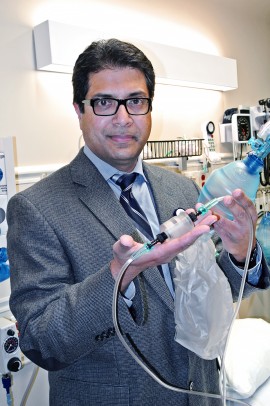Physician-inventor finds solution for oxygen problem

Girish Deshpande, associate professor in pediatrics at the Peoria campus, designed a portable, hand-held oxygen blender to reduce early oxygen toxicity.
Oxygen is critical to life. But too much oxygen can be toxic.
For Girish Deshpande, associate professor of pediatrics in the College of Medicine at Peoria and a pediatric intensivist at Children’s Hospital of Illinois, seeing young patients in pediatric intensive care who received too much oxygen inspired him to come up with a solution.
“My feeling about oxygen is that we use it excessively,” says Deshpande. “It is an essential element that we all need, but if you look, more and more articles are recommending use of less (than 100 percent) oxygen, including the moment a patient regains respiration following resuscitation for cardiorespiratory arrest.”
The problem with current oxygen blenders, Deshpande says, is they are either not portable — large and mounted to walls in the hospital — or they are incorporated into oxygen masks, not reusable or adjustable for the amount of oxygen the patient receives.
He came up with a design for a portable, hand-held oxygen blender to reduce early oxygen toxicity. It’s adjustable, reusable, fits into any standard oxygen tubing, and cheap to reproduce.
“It’s all in the design,” Deshpande says, pointing to one of his drawings and holding an acrylic plastic prototype.
The device incorporates elements found in current oxygen blenders. But with a simple twist, more room air can enter the central chamber, saturating the amount of oxygen a patient receives. Nozzles at both ends of the device mean it can be plugged into any standard oxygen tubing.
Deshpande says the device could be used when patients are transported by ambulance or between departments in a hospital. He says it’s ideal for urban and rural settings as well as health care facilities in developing countries because of its simplicity and reusability.
Deshpande, who received a Chancellor’s Innovation Fund award, worked with engineering students and Terry Layton, lecturer in bioengineering, to bring his design to life and holds a provisional patent for the device. He is presenting his work at the International Mechanical Engineering Congress & Exposition in Montreal this week.
“Working in the ICU, I see the need for us to reduce the chances for oxygen toxicity,” he says. “Newborns are extremely vulnerable. We know it can cause damage to brain, eyes, lungs and other organs. It just makes sense.”
David Haney is director of strategic communications for the College of Medicine at Peoria.
